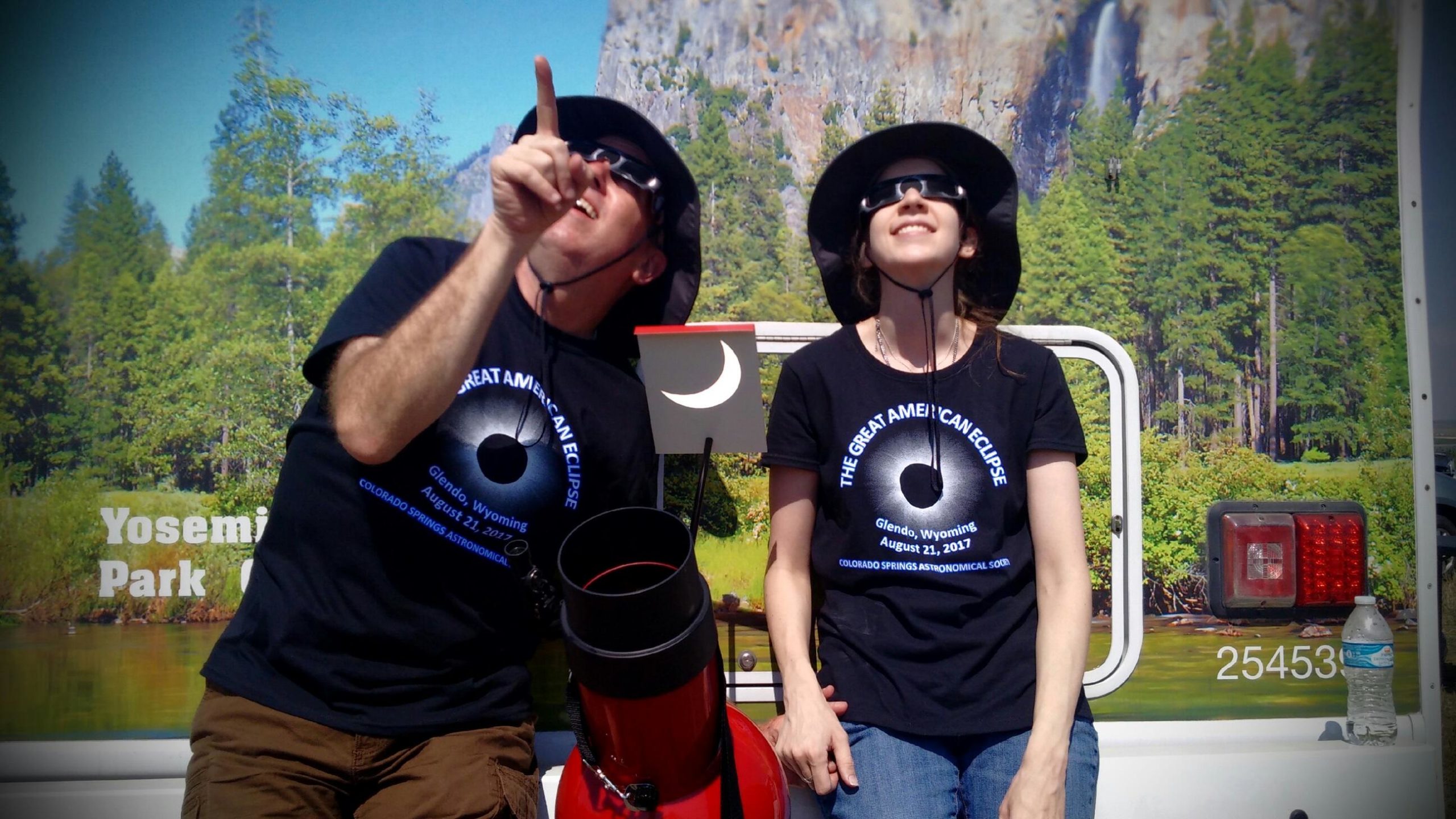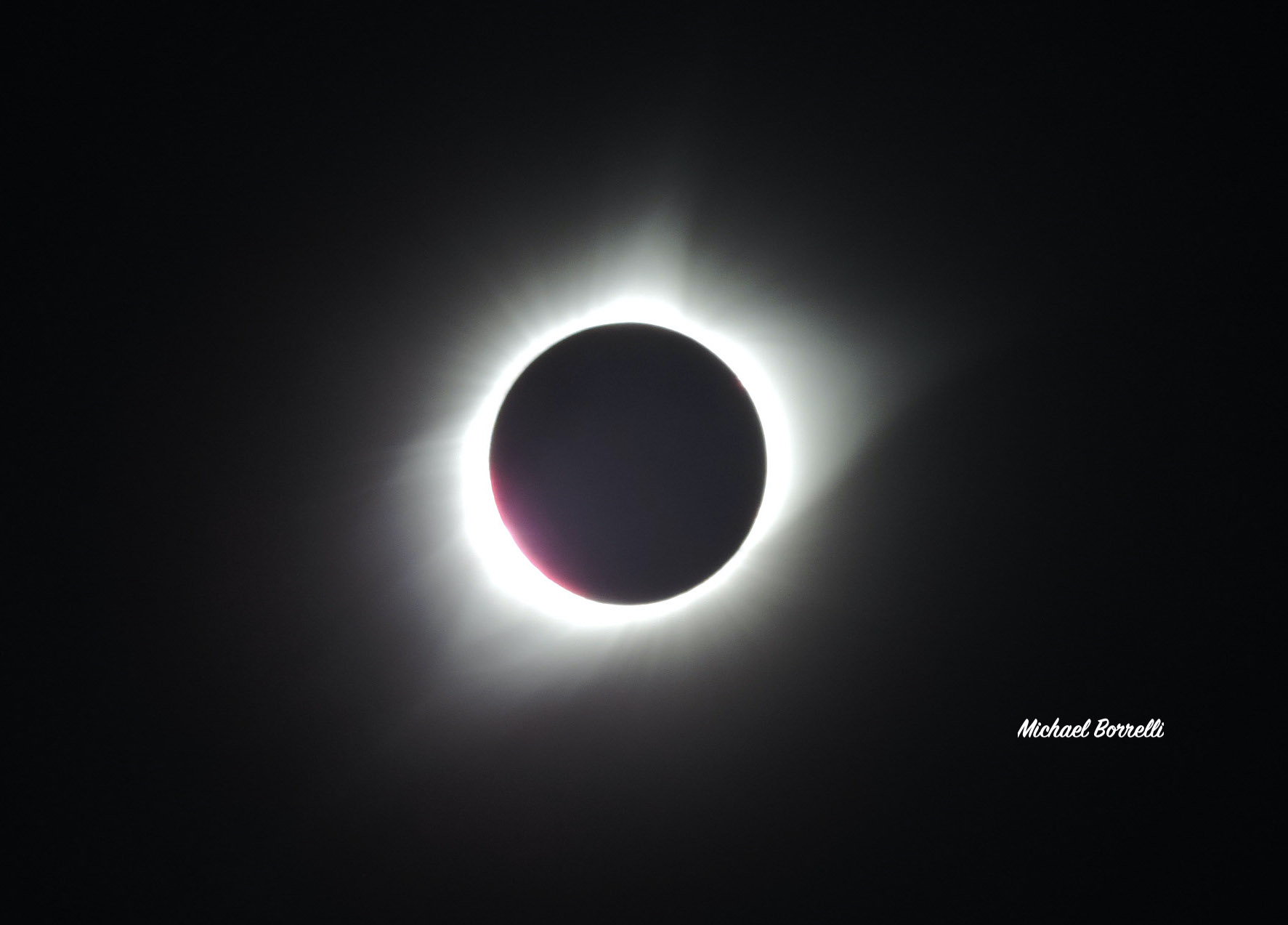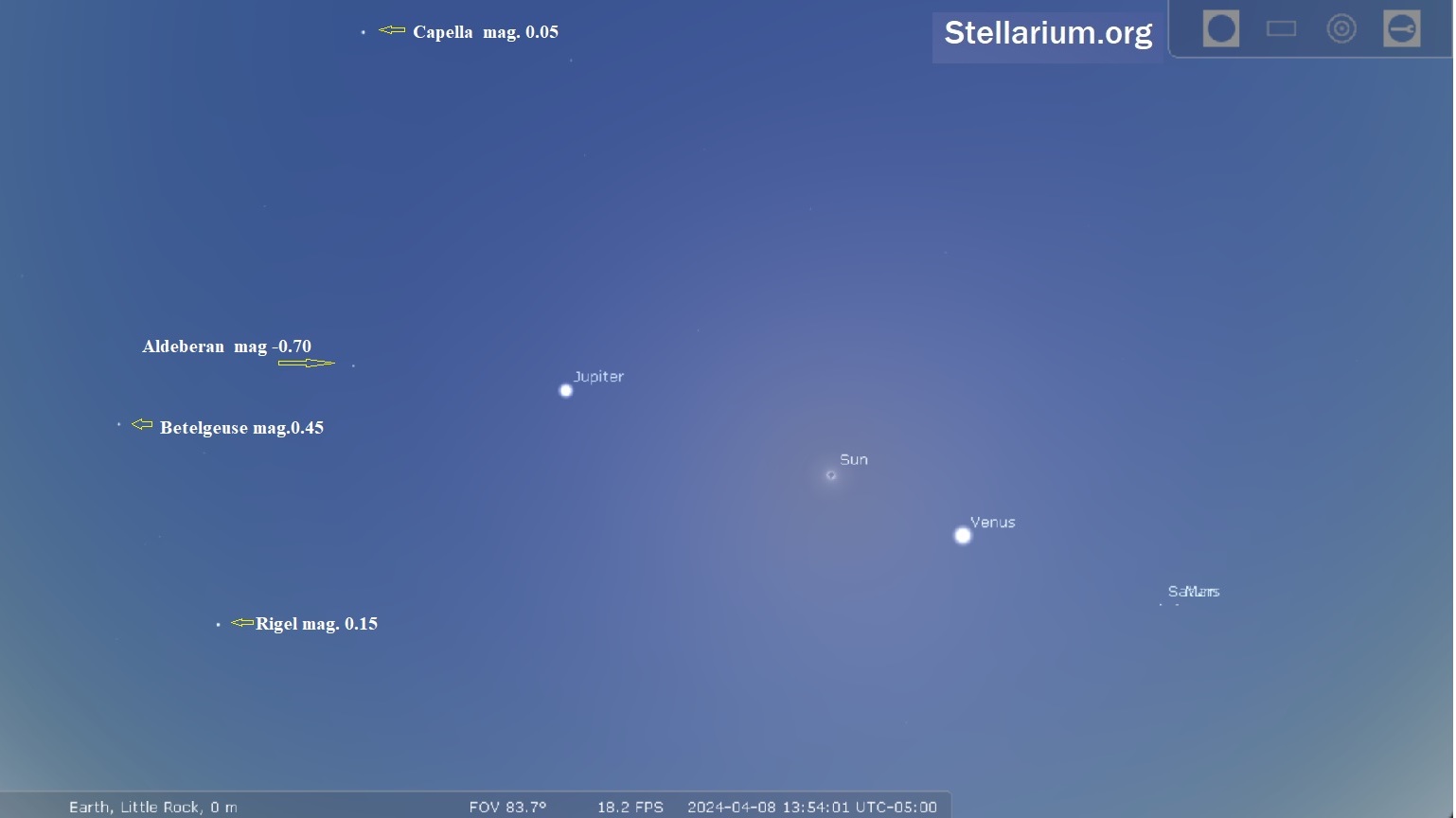Observing a Total Eclipse
Introduction
There is more to observing a total eclipse than you might imagine. So, we start with getting our head around the mechanics of a total eclipse and why they are so rare. Then we will define the four stages that define the anatomy of a total eclipse and the phenomena we hope to experience. Finally, we will walk through the experience of observing a total eclipse. Along the way, you will realize that there is planning involved. The links at the bottom of the page will lead you to more information, and our newsletter, which will inform you of programs, workshops, and changes to this website.
Understanding a Solar Eclipse - Why they are so rare
In a total eclipse, the moon passes in front of the sun and blocks its light out. If it is that simple, why aren't eclipses more common? After all, the new moon passes on the sun's side of the earth every twenty-nine and half days. The answer is that the moon's orbit around the earth is tilted. Consequently, most new moons pass below or above the plane of the earth's orbit around the sun. The moon only subtends half a degree in the sky, so the new moon has to occur precisely when the moon's up and down wandering align with the plane of the earth's orbit to produce an eclipse.
The next question one might ask is how can the moon, as small as it is, cover the sun. The answer is that while the moon is four hundredths the sun's diameter, fortune has incredibly arranged it such that it is also four hundred times closer to the earth than the sun. Not only does this unlikely arrangement give us the spectacle of a total eclipse, but in just covering the sun's disc, it has made it possible to learn all manner of things about the sun itself. A total eclipse even provided the first proof of Einstein's theory of relativity.
Even with perfect alignment, you don't necessarily get a total eclipse. The moon's orbit is not only inclined; it is also not perfectly round. Sometimes it is closer to the earth and sometimes further away. If an eclipse alignment occurs when the moon is more distant, it does not quite cover the sun, and we get an annular eclipse. Not covering the sun's disc, annular eclipses, like partial eclipses, don't provide the same phenomena or experience as a total eclipse.
The partial eclipse that we here in Arkansas will experience on October the 14th, 2023 will be an annular eclipse in Texas, which points up that what you witness during an eclipse, indeed whether you see it at all, depends upon your location on the earth. Hold your hand out and cover a ceiling light fixture in an adjoining room with a finger while looking through one eye, then change eyes without moving your finger. Outside of totality, the moon passes across the sun either a bit high or low such that it never covers it all, so you get a partial eclipse. The further you are from totality, the less of the sun is covered. The totality area on earth is in the umbral shadow of the moon, where all direct sunlight is blocked. The area outside of totality, where there is a partial eclipse, lies in the penumbral shadow.
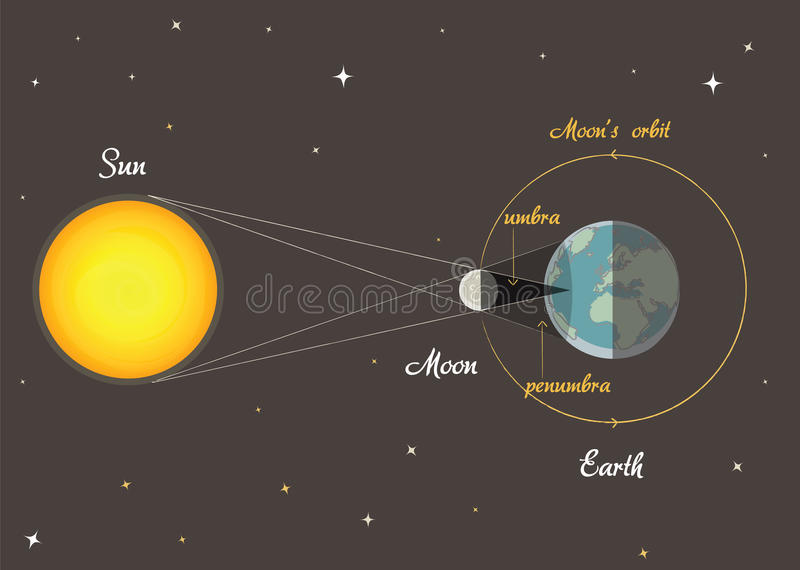
The five phases of a total eclipse:
- First Contact is when the moon's leading edge contacts the sun's near edge. It marks the beginning of the partial eclipse phase.
- Second Contact is when the moon's leading edge reaches the far edge of the sun, marking the beginning of totality. The approach of Second Contact is when all the neat things unique to a total eclipse start to occur.
- Totality is the period between Second Contact and Third Contact and the only time when you can safely observe the event without protective eyewear.
- Third Contact is really a loss of contact and occurs when the sun's trailing edge reemerges resuming a partial eclipse phase.
- The fourth contact is when the moon's trailing edge ceases to cover any of the sun, marking the end of the eclipse.
Where It Begins
The total eclipse experience begins with the excitement of learning about the total eclipse experience, which you are doing now, and if a novice should continue with participation in one or more programs to delve into the details of developing a plan. But for now, let's jump forward into the actual event.
The Darkening
At first, the darkening is not perceptible. It is only a small sliver of the leading edge of the moon that is covering the sun, and your eyes adjust to the gradually dimming light. But as the moon's full diameter starts to come into play, and the sun becomes a crescent, the growing darkness becomes obvious, and the pace of change accelerates. Note the time and temperature at intervals. In the final minutes before totality, looking in the direction from which the shadow is coming, you can see totality approaches. Note the time and temperature.
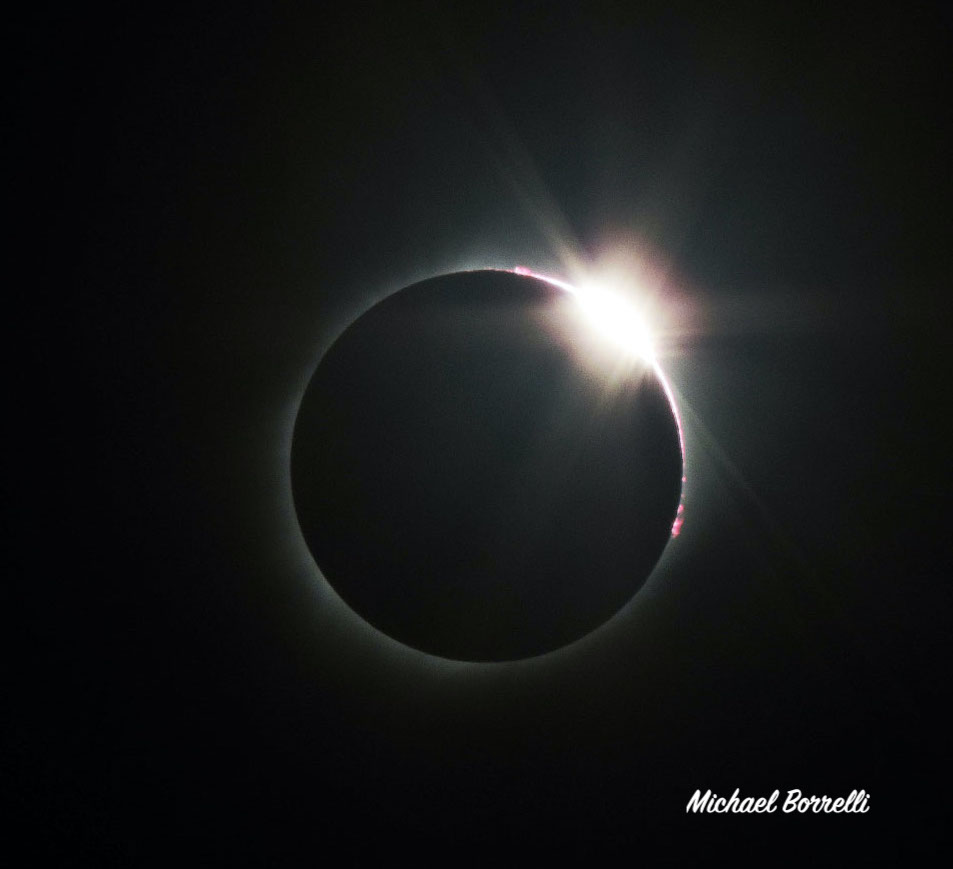
Second Contact Nears
Now the pace of things picks up. It will be hard to see and take it all in. While there is almost no sunlight falling directly upon where you are, the distant horizon on either side of totality is dimly lit. This is the time to note any unusual behavior of birds, insects, and other wildlife. Also, look for the shadow bands on the ground around you – wavy bands of light and dark caused by the atmosphere refracting the last thin crescent of sunlight.
Second Contact Arrives
It happens fast. As the moon's disc is just about to cut off the sun's disc, you get the diamond ring effect and Baily's beads. The diamond ring is caused by the last tiny arch of the sun's photosphere, with the diamond being the place where the remaining gap is the largest. Baily's beads follow and are places where the lunar surface's uneven terrain allowing the last tiny slivers of photosphere to shine through. When the diamond ring and Baily's beads are gone, the Second Contact is complete. You can remove your glasses and use unfiltered binoculars or other instruments to view totality.
Totality
This will only last a matter of minutes. There are three features that are only visible during totality. The corona - the sun's very thin but very hot outer atmosphere that extends way out from its surface. Solar prominences are eruptions of solar plasma from the surface and appear as pink areas extending out past the lunar surface. The chromosphere – arcs and beaded areas, like Baily's beads, but pink in color visible in places around the moon's edges, caused by the sun's lower atmosphere shining through. In addition, the brighter stars and planet, if near the sun, should be visible.
It's A Memory Now
You have just witnessed a magnificent once-in-a-lifetime phenomenon of nature that brings the reality of our place on this small orb circling a lonely star adrift in a vast universe into a moving experience. You have the notes of your experience and perhaps a few images. The next great North American eclipse is twenty-one more years away, and believe it or not, it too crosses through Arkansas, this time west to east. To witness one total eclipse is rare enough to witness two rarer still. To witness them from the same spot – jackpot odds. If you are young enough, you have a shot at it. Just set up about eight miles south of Ola in Yell county for the April 8, 2024 eclipse and return Aug. 12, 2045, and nab your claim to eclipse fame when the paths cross.
In the meantime, you can learn to explore the night sky where there are thousands of suns to be seen and where who knows how many eclipses are happening.
Links to Additional Resources
- Eclipse Work Shop April 9th and 10th.
- eclipsophile - Weather Forecast based on historic weather patterns
- American Astronomical Society - Eclipse Safety
- Make a pinhole camera JPL/NASA.
- NASA Edge - If heaven forbid, it clouds out you and can watch it live.
- AR-Eclipse.info Newsletter - News about workshops, events, & changes to this website
- Eclipse Glasses - (To be added)

